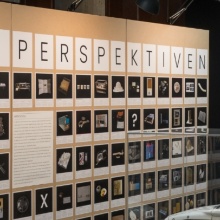In the program accompanying the exhibition "AT A SECOND GLANCE. Ramblings through the Collections of the University of Stuttgart", a panel discussion on the potentials and perspectives of the collections at the University of Stuttgart took place on May 18, 2022. Prof. Dr. Christian Bonten (Head of the Institute of Plastics Technology), Prof. Dr. Klaus Jan Philipp (Head of the Institute of Architectural History), Dr. Christiane Rambach (University Library) and Prof. Dr. Robert Schulz (Head of the Institute of Materials Handling and Logistics) spoke under the moderation of PD Dr. Beate Ceranski (Department of History of Science and Technology, Hist. Institute) about the importance and use of the collections for teaching, research and representation.
Christian Bonten brought as a demonstration object a workpiece full of intentional errors, which helps to teach construction with plastics in teaching. As a second object, he showed an ivory telephone from the 1950s that is exciting in terms of cultural and consumer history. Christian Bonten, who works on an honorary basis at the German Plastics Museum, represents two complementary and equally important aspects of collecting: the constantly supplemented teaching collection of objects that he has collected himself and produced professionally is juxtaposed with the museum collection, which is concerned with the permanent preservation of objects that have become historical - a two-faced approach to university collecting that can be found at many institutes.
Robert Schulz showed a wire rope of a cable car as a demonstration object, which shows a damage of the rope caused by a lightning strike. Grown out of the institute's research and expert activities, the object is now used in teaching in a change of function typical of university collections. Beyond the rope collection, which is unique in Germany, the institute holds prototypes of automated logistics vehicles, which in retrospect are significant in the genealogy of autonomous driving. By perceiving and preserving objects from the development of an emergent technology as such, it became clear in the conversation, he ensures future access to the material witnesses of significant technical innovations as an archivist of his subject.
Klaus Jan Philipp brought several small valuable drawings by the well-known Stuttgart architect C. F. von Leins as samples. The architectural drawings are one of several collections housed by the Institute for the History of Architecture as an institute that has always collected and taught and researched with collections. But even with great professional importance and use in teaching, research, and exhibit lending, the architectural historian made clear, the collections have a latent precarious status, as the resources to store and care for them must always be secured anew, such as when there is a change in professorship and institute leadership.
Christiane Rambach had a decommissioned card index box with her, which she used to illustrate the importance of standardized recording of objects - which everyone is talking about today as metadata management. Specialized in the collection and management of data and metadata, the university library could, in the future, act as a competence center to support the people in charge of the collection and the institutes holding the collection, and to accompany their processes. An important role could be played here by a central building for science (campus HUB) spanning libraries and university departments, the concept study for which was funded by the MWK in 2019-21. A first (not yet complete) rough survey of collections at the University of Stuttgart was also carried out as part of this project. As a central academic learning place of the city center, the C-HUB could not least also give (selected) objects a place.
In the second part, those present in the plenum also contributed with questions and contributions. In addition to exciting reflections on the self-image of the collections and those responsible for them, the focus was also on ideas and suggestions on how the rich potential of the collections could be used even more than before. A university museum as a central location would be the ideal solution and very appropriate for Stuttgart's scientific importance, as several speakers suggested. But even on a smaller scale, the collections make exciting new projects possible when the subjects network. The invitation to the June reenactment - on the original Zuse machine! - of the stochastic poetry developed in Stuttgart was therefore a fitting conclusion to this perspective-rich and entertaining evening.
Beate Ceranski



